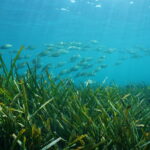[This is the second of two articles on useful tools for each phase of offshore wind energy development. Check out blog one introducing specific tools for solving engineering challenges here.]
Did you know there are special data and analysis tools that can be used throughout each offshore wind farm development phase to manage marine environments more sustainably? Having such quality environmental data and analyses tools for an offshore project helps developers and operators:
- Reduce uncertainty about environmental impacts and investment risks
- Make more informed and strategic development decisions
- Obtain development approvals
- Improve safety and efficiencies within operations
- Align projects with the United Nations Sustainable Development Goals
The methods, data and modelling tools presented below help to understand and sustainably manage marine environments and identify potential impacts early. We broadly break down an offshore wind farm’s phases into (1) Strategic site selection, (2) Planning and development, (3) Installation and construction, (4) Operations and maintenance, and (5) Decommissioning.

Phase 1: Site selection
Site selection refers to the process by which government agencies outline offshore wind farm concessions. Part of that concession includes determining if an area or specific site is environmentally feasible.
Various modules in the MIKE 21/3 modelling suite are used to assess both the engineering and environmental challenges. To assess environmental sensitivity in this phase, the Marine Animal Movement Portal (MAMP) can generate detailed maps of mobile marine animal species movements and distribution in and around a wind farm site.
Want to apply data to your strategy? Tools like ABM-Lab and MIKE Underwater Acoustic Simulator (UAS) can assess environmental impacts of various scenarios and mitigation strategies to find the most cost-effective methodologies with the smallest environmental footprint.
Dynamic habitat modelling using ABM Lab can identify environmental variables, like currents, that affect marine animal movement . These models produce habitat suitability maps showing potential marine animal hot-spots, sensitive areas and other important zones.
The best part? These data and modelling tools can be used in subsequent phases of development.
Phase 2: Planning & development
Before any construction starts, formal environmental applications and approval procedures by local, national and/or international governing bodies are required. The most recognised procedures include environmental impact assessments (EIAs).
There are several smart tools and practices that can help you collect and analyse data required for an offshore wind project’s EIA. These include:
- Passive acoustic monitoring and visual surveys to identify marine mammals and habitats
- MIKE Underwater Acoustic Simulator (UAS) to model the reach of underwater noises caused from development activities. Combine MIKE UAS with dynamic habitat modelling to investigate the number of marine animals within the noise range and their reactions to it.
- Sediment plume modelling to support other impact analyses
Phase 3: Installation and construction
This phase may require submission and approval of a Construction and Operations Plan (COP). A COP describes all proposed activities on a lease area, including data and results from surveys analysing direct and indirect environmental and socioeconomic impacts of the project.
When managing marine habitats during this phase of development, having a digital Marine Animal Movement Portal (MAMP) can help generate detailed maps of mobile marine animal species movements and distribution in and around a wind farm site. This is particularly important when it comes to noise monitoring.
To validate impact assessments and verify compliance with marine life noise criteria, underwater noise monitoring and mitigation measures are typically required. Mitigation measures can include engineering solutions that make the sound sources quieter. Measures can involve creating sound barriers—like air bubble curtains—around a turbine pile-driving site. Specific sounds can also be produced that result in marine mammals leaving the immediate zone of danger before construction activities start.
Phase 4: Operations and maintenance
Environmentally sustainable offshore wind projects have a data-backed operations and maintenance (O&M) strategy that includes preventive and reactive activities.
While there is no inclusive list of all possible monitoring scenarios, below are prominent industry tools for environmental monitoring in this phase:
- MUSE (multi-sensor bird detection) combines radar technology with infrared cameras to monitor seabirds and migrating birds 24/7
- Passive acoustic monitoring keeps track of marine mammal and fish activities
Phase 5: Decommissioning
Many of the decommissioning processes can be compared to installation processes, but in reverse. Decommissioning activities need to be in accordance with initial permitting conditions for the project.
Appropriately, this includes conducting an environmental impact assessment (EIA) of decommissioning plans for the environmentally neutral removal of offshore substructures and foundations, as well as their transportation to shore. Decommissioning EIAs are like the ones described in the planning and development phase. These EIAs can be developed using similar tools, like the MIKE Underwater Acoustic Simulation (UAS), to create numerical models to assess impacts of decommissioning activities.
Sustainable marine environment management
Offshore wind is one of the world’s best chances in the clean energy transition. While cost and scalability are key factors for a project’s success, it’s imperative to also consider sustainable management of marine environments.
Understanding and managing the unique marine environments of offshore wind farms can be complicated, but it can be easier. There are plenty of specialty tools and expertise available as mentioned above, to get you started.








